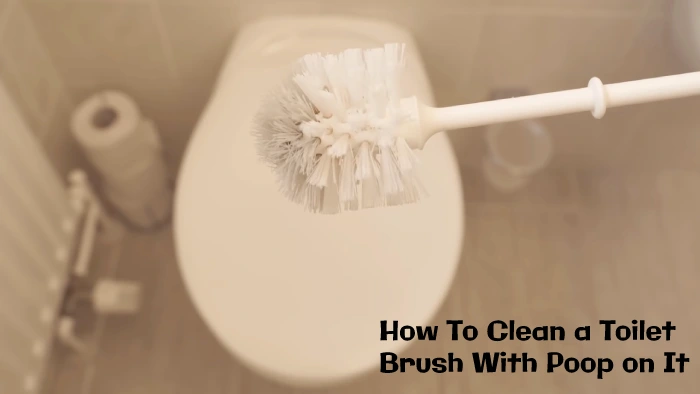Last Updated on October 17, 2023
Imagine this scenario: you have just finished using the toilet brush to clean your toilet bowl, but unfortunately, there is some sticky poop residue on it. You cannot ignore it or leave it uncleaned since that could pose serious health risks. So what do you do?
Two effective methods to clean poop residue from a toilet brush include using a hot water and bleach solution, detergent, or an equivalent disinfectant. Both require attention to detail and patience, but each method effectively removes any sticky residue.
We will go into two successful methods enabling you to reinstate your toilet brush to its pristine state.
How to Clean a Toilet Brush with Poop on It: Cleaning Procedures
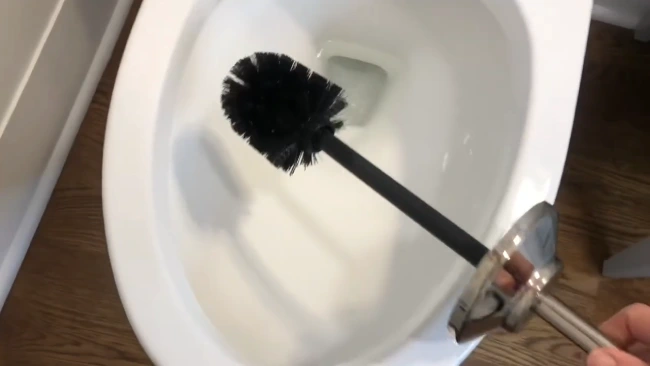
To effectively clean a toilet brush contaminated with feces, it is imperative to utilize appropriate cleaning products and tools. Below are two proficient methods for cleaning a poop-hidden toilet brush:
ONE: Washing with Hot Water and Bleach
1. Safety first
Safety measures should be the priority when cleaning a toilet brush covered in feces. Wearing disposable gloves and avoiding direct contact is crucial to protect against harmful bacteria and germs present in fecal matter.
The use of hot water and bleach can effectively eliminate pathogens. Ensure the toilet area is well-ventilated to reduce the risk of inhaling unpleasant odors or fumes.
2. Prepare a bucket
A receptacle with enough depth to submerge a cleaning tool and its holder is necessary to manage hazardous waste effectively. A deep bucket made of non-porous plastic is preferred when cleaning a toilet brush with feces. This makes it easier to clean and less likely to harbor bacteria.
The bucket should be deep enough to submerge the brush and holder to avoid contact with harmful viruses and bacteria.
3. Heat water
Sanitizing toilet brushes contaminated with fecal matter with scalding hot water is critical to achieving optimal cleaning results. High-temperature water can dissolve organic matter on the bristles and kill bacteria and viruses.
Add boiling water to a bucket with a maximum heat setting using a kettle. This can remove stubborn poops and odors.
4. Add Bleach
Bleach is a powerful disinfectant that can easily kill bacteria and eliminate unpleasant smells. The hot water makes the solution more effective at breaking down dirt and grime, leaving your toilet brush germ-free and smelling fresh.
Add bleach and stir the solution with the hot water bucket to mix it evenly. Always measure out the proper amount of bleach (approximately 2 cups) for maximum effectiveness.
5. Submerge the Brush
After the solution is ready, submerge the toilet brush and holder in it. This helps to kill any harmful bacteria or viruses that may be present on the brush’s bristles and dissolve any remaining organic matter.
Immersing the tool in this solution for at least an hour can effectively remove germs and fecal matter that may have accumulated during previous use.
6. Rinse Underwater
After soaking, remove the brush and holder from the bleach water and rinse under hot water for 30 seconds. Thoroughly rinse to eliminate bleach residue and debris. This step is important for removing any fecal matter or buildup from previous uses.
Proper rinsing also helps with odor elimination caused by exposure to bacteria and contaminants.
TWO: Use Detergent Or An Equivalent Disinfectant
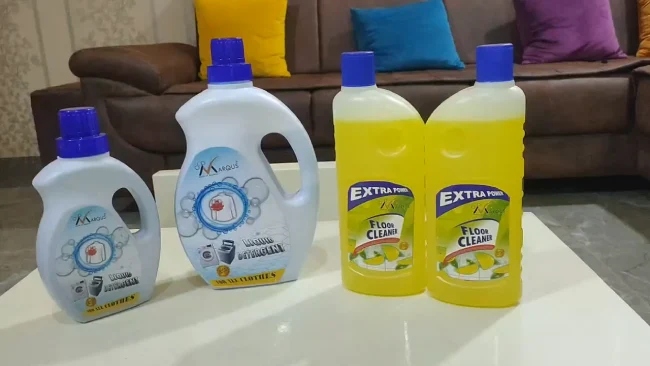
Step 1: Prepare the Disinfectant Solution
When preparing a disinfectant solution, carefully read the instructions on the bottle to determine the appropriate dilution ratio. Wear rubber gloves while handling the toilet brush. Mix the solution in a bucket or toilet brush holder and immerse the bristles.
Step 2: Soak and Scrub the Brush in the Solution
Submerge the contaminated bristles in a diluted disinfectant solution for at least five minutes and gently agitate them to ensure full coverage. Then, scrub both the handle and bristles to remove any leftover debris or residue.
This process is crucial when cleaning a toilet brush that has come into contact with fecal matter. Be sure to soak all bristles and scrub them vigorously and thoroughly.
Step 3: Rinse the Brush with Hot Water
After scrubbing, use hot water to eliminate any remnants of the disinfectant solution. Ensure that every part of the brush is rinsed off before examining the bristles for any traces of debris or fecal matter. Keeping the brush clean will also prevent germs from spreading.
Remember that soaking your toilet brush in disinfectant for too long can damage its bristles, making it ineffective at cleaning. Therefore, avoid soaking your brush for too long. Instead, clean and rinse it promptly after use to extend its lifespan.
How often do you need to clean your toilet brush?
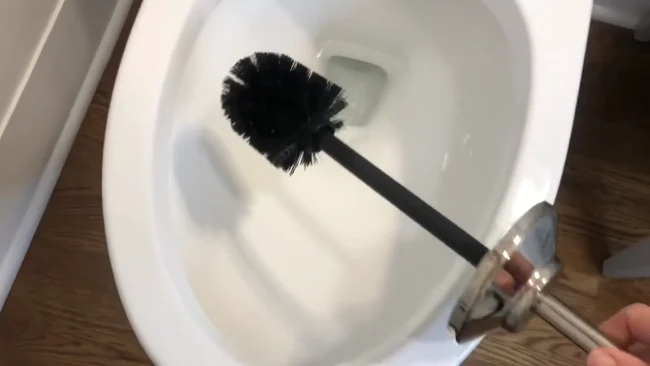
Regular cleaning and maintenance of toilet brushes are essential for hygienic purposes and should be done at least once a week. After every use, clean the brushes thoroughly, especially if they’re stuck with feces.
If this occurs frequently, it may indicate that the toilet brush requires more frequent or intense cleaning. And even with regular cleaning, don’t forget to switch out your toilet brush every six months to maintain a healthy environment.
Can the sticky poop be removed by soaking the toilet brush in water?
Maintaining proper bathroom hygiene necessitates thorough disinfection of sanitation tools. Simply soaking a toilet brush in water will not adequately remove sticky poop residues and harmful bacteria.
While the method may loosen fecal matter, it is insufficient for comprehensive cleaning. Poop comprises harmful bacteria that can easily transfer from contaminated surfaces to the bathroom or even human bodies.
Therefore, using a natural solution or disinfectant when cleaning your toilet brush is suggested. It ensures that all germs and residues are eliminated. After each use, clean the toilet brush to prevent buildup and make deep cleaning easier.
Does a toilet brush dry fast after cleaning the sticky poop from it?
Whether it’s the humidity in your bathroom or the bristles themselves, several factors affect the drying time of your toilet brush. In most cases, it takes 30 to 60 minutes for a toilet brush to dry completely.
Then again, this can vary depending on how much water was used during cleaning and how well the brush was rinsed and dried before storage. You should always let a toilet brush air dry completely before storing it to keep it clean.
Vanish nasty odors and bacteria from your toilet brush by following these easy drying and storing tips
Maintain Bathroom Hygiene: Clean Your Toilet Brush
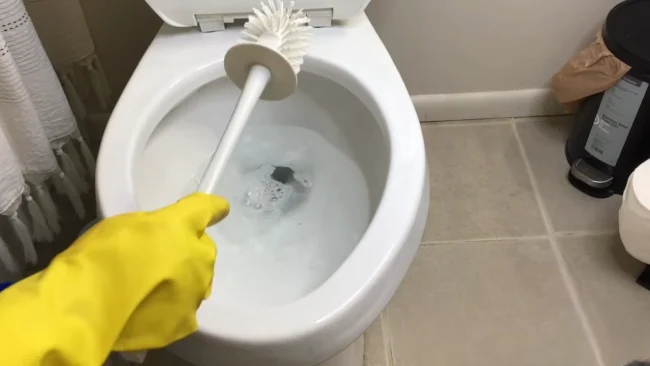
Maintaining good bathroom hygiene is an essential part of supporting both our personal health and the health of our loved ones. You shouldn’t forget to clean the humble toilet brush, which is often overlooked. While cleaning a brush that has had contact with fecal matter may seem daunting, there are options.
Two easy methods are available for sanitizing their toilet brush effectively. Utilizing bleach or disinfectant can help eradicate harmful bacteria while removing unsightly poops. Alternatively, soaking the brush in hot water infused with either vinegar or baking soda for a few hours can also prove effective.
By taking these simple steps to maintain our toilet brush, we can create a safe and healthy environment for all.

